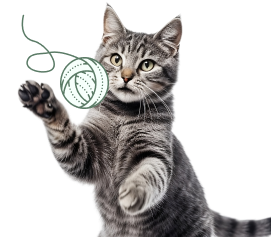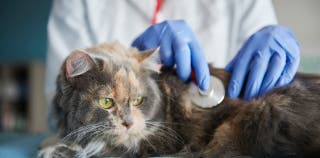What factors impact the cost of pet insurance?
There are several factors that can influence the cost of your pet insurance plan. By having these in mind and understanding how they work, you can ensure you get the right coverage for an affordable price.
The main factors that affect the cost of pet insurance are as follows.
1. Type of coverage
There are three main types of coverage:
-
Accident-only plans (AO): These plans only cover accidents and unexpected injuries. In some cases, it may cover certain procedures. Since these plans are typically not comprehensive, they tend to be cheaper.
-
Accident-and-illness plans (A&I): These policies are more comprehensive. They’ll come at a higher cost, but they’ll cover things like tests, lab work and prescriptions (in most cases).
-
Wellness care plans: This coverage for preventative care is typically offered as an optional add-on. It can cover things like vaccinations, dental reviews & cleanings, or even more holistic treatments like acupuncture.
If you are unsure what you need in a plan, take a look at our guide to what pet insurance covers.
2. Deductible amount
A deductible amount is how much you’ll pay out of pocket before your insurance policy starts to kick in. It can be an annual, per-incident, or per-condition amount. The higher your deductible amount, the lower your monthly pet insurance payment will be.
3. Max annual coverage limit
The maximum annual coverage limit is how much your insurance company will pay out to cover your pet each year. Coverage limits can range from a few thousand dollars to unlimited coverage. The higher the coverage limit, the more you’ll pay per month.
4. Reimbursement percentage
There aren’t many insurers that will pay the vet directly for you. Typically, the vet will treat your pet, and you will pay for the service out-of-pocket and be reimbursed by the insurance provider after. The reimbursement percentage is the percentage of the vet bill you will be reimbursed for by your insurance company. The higher your reimbursement percentage is on your insurance policy, the more expensive the policy will be.
5. Your pet’s age
As your pet’s age is often a huge factor in the likelihood of illness, this has a big impact on how much you’ll pay for pet insurance. Premiums for senior animals are more expensive. Some insurance providers don’t even cover pets who are older than a certain age.
6. Your pet’s breed
Whether you have a dog or a cat, some breeds are more prone to inherited disorders or other conditions. For example, large dogs (like retrievers) commonly have hip or elbow dysplasia. Breeds prone to health issues typically cost more to insure.
7. Your location
Pet insurance costs vary based on where you live. Insurance policies often cost more in metropolitan areas.
8. Discounts
You may be able to get a discount on pet insurance if:
- You’re insuring multiple pets
- You’re a member of the military
- You’re adopting a shelter pet
- You have a service dog
- You’re a senior
- You work for a veterinary practice
Now you know the main factors that influence the overall cost of pet insurance let’s have a look at specific cost examples for cats and dogs that show how each variable affects the overall cost.
We’ll start with dogs, but you can skip ahead to the section on cats by clicking here.
Cost of pet insurance for dogs
As we mentioned, the average cost of dog insurance is around $50 per month, although this number can change when you look at determining factors such as the breed of your dog, age, and plan inclusions.
Below you will see how each of these variables influences the cost of dog insurance:
- Dog breed
- Dog age
- Deductible amount
- Reimbursement percentage
- Annual limit
Cost of dog insurance by breed
It is well documented in the world of pet ownership that a desire for pedigree breeds and overbreeding have contributed to a rise in health problems with certain breeds of dogs. As a result, certain breeds require increased medical attention and intervention, and if your dog is of a breed that’s prone to more health conditions, you can expect to pay more for dog insurance.
We compared quotes for five popular dog breeds from Embrace Pet Insurance, PawProtect, and Fetch for a five-year-old dog.
Dog breeds such as the French Bulldog are renowned for their chronic health problems and top the list for higher insurance costs, coming in at $76.28. Taking the mid-table spot are breeds such as the German Shepherds and Poodles, with an average cost of $51.89. Other popular dog breeds, such as the Golden Retriever and Labrador Retriever, are seen as breeds less costly to insure, with an average cost of $49.26.
You can see the average quote for each dog breed in the table below.
| Breed of dog |
Cost |
| French Bulldog |
$76.28 |
| Labrador Retriever |
$49.26 |
| Golden Retriever |
$49.88 |
| German Shepherd |
$51.89 |
| Poodle |
$51.38 |
Cost of dog insurance by age
As with any type of health insurance, age is a critical factor in determining the price of your monthly premium.
It may not be a surprise to note that older animals are often more expensive to insure as they become far more prone to health problems and often require more frequent medical treatment. However, you may be surprised to know that very young puppies can also be slightly more expensive to insure than dogs that are already a few years old.
This being said, the overall dominant trend is that insurance prices rise as your dog ages.
We can see this in the following example. By looking at insurance quotes for a Labrador Retriever from Embrace Pet Insurance, PawProtect, and ASPCA Pet Health Insurance, we were able to observe how age affects the price of dog insurance.
On average, a dog at three months old will cost more to insure than a fully grown pet – setting you back $42.65 on average. As your dog ages through years one, three, and five, the average price of pet insurance also steadily rises from $40.55 to $41.15 and $49.26, respectively. Prices can be upwards of $100 once your dog reaches ten years of age. Using our example one last time, insurance cover for a 12-year-old Labrador Retriever was quoted at around $125.70.
We present these average quotes for different ages in the following table.
| Age of dog |
Cost |
| Three months |
$42.65 |
| 1 |
$40.55 |
| 3 |
$41.15 |
| 5 |
$49.26 |
| 7 |
$60.46 |
| 10 |
$94.77 |
| 12 |
$125.70 |
It’s important to remember that these prices are for example purposes only and that the final cost of your pet insurance policy will vary depending on your individual circumstances.
Cost of dog insurance by deductible
Before moving on, it’s important we address certain terminology and lingo relating to pet insurance policies, and this includes understanding the meaning of a plan deductible.
A plan deductible is how much you must pay out of pocket before your insurance kicks in. The higher your deductible, the cheaper your plan will be. In general, the higher your deductible is, the cheaper your insurance plan will be, and vice versa.
We used different deductible amounts to compare dog insurance costs for a 5-year-old Labrador Retriever from Embrace Pet Insurance. We kept the annual limit at $8,000 and the reimbursement rate at 70%.
Keeping all variables the same, you can see how the deductible amount can change the cost of pet insurance policies in the table below.
| Plan deductible |
Cost |
| $1,000 |
$34.11 |
| $750 |
$39.68 |
| $500 |
$48.04 |
| $250 |
$58.48 |
| $100 |
$69.6 |
The lower your deductible is, the more your pet insurance policy will cost. Therefore it’s important to judge how often you anticipate using your pet insurance policy to see if it’s worth raising or lowering your deductible amount.
Cost of dog insurance by reimbursement percentage
With most pet insurance policies, your pet insurance provider will reimburse you for a percentage of what you paid the vet for care. Plans with a higher reimbursement percentage generally have a higher cost, but you’ll get more money back when the vet bills come in.
To see how changing your reimbursement rate affects the overall cost of pet insurance, we received quotes from Embrace Pet Insurance for a 5-year-old Labrador Retriever. We used different reimbursement percentages, but we kept the deductible at $750 and the annual limit at $8,000.
What this data showed was that there is, on average, a $6 increase in dog insurance costs for every 10% reimbursement percentage you receive. For example, to receive a 70% reimbursement, your monthly payments would stand at around $48.04. To be reimbursed for 90% of your veterinarian fees, your monthly fee would increase to $60.05. These are just hypothetical examples, and actual costs will depend on your individual circumstances. However, this example can help orient you to how reimbursement rates can affect your premium price.
Here is that data again in table form.
| Reimbursement percentage |
Cost |
| 70% |
$48.04 |
| 80% |
$54.04 |
| 90% |
$60.05 |
| $250 |
$58.48 |
| $100 |
$69.6 |
Cost of dog insurance by annual coverage limit
Your annual limit is the maximum amount of money your provider will reimburse you for each year. Plans with higher limits tend to cost more, but the cost can balance out. If you are aware that your dog may need multiple trips to the vets across the year, paying slightly more for a higher annual reimbursement limit can be a wise choice,
To give you an example, we used different annual limits to compare Embrace Pet Insurance quotes for a 5-year-old Labrador using different reimbursement limits. We kept the deductible at $750 and the reimbursement rate at 70%.
The results show that for a $5,000 annual reimbursement limit, your monthly premium could cost around $49.13. To increase this to $10,000, monthly costs would rise to $55.52. Finally, for an unlimited annual reimbursement limit, premiums can cost, on average, $68.78.
You can see this data in the table below.
| Max Annual Coverage |
Cost |
| $5,000 |
$49.13 |
| $8,000 |
$54.04 |
| $10,000 |
$55.52 |
| $15,000 |
$59.94 |
| Unlimited |
$68.78 |
Keep in mind actual costs will vary depending on individual circumstances.
Cost of pet insurance for cats
Based on our research from data compiled by cat insurance policies sold over the last year, the average pet insurance cost for cats is around $20 per month.
Cat insurance tends to be cheaper than dog insurance. This is because, in general, cats don’t need as much veterinary care as dogs—they go to the vet less, and indoor cats, in particular, aren’t as likely to get injured.
To give you an idea of what you can expect to pay for cat insurance, we applied the same variables we used to compare the cost of dog insurance:
- cat breed
- cat age
- deductible amount
- reimbursement percentage
- annual limit
Cost of cat insurance by breed
As with dogs, the type of cat you have impacts the cost of pet insurance. This is based on the fact that certain breeds are more susceptible and predisposed to particular illnesses. For example, breeds such as the Maine Coon are far larger and can commonly develop hypertrophic cardiomyopathy.
Taking this into consideration, we took the average quote from Embrace Pet Insurance, ASPCA Pet Health Insurance, PawProtect, and PetsBest.
| Breed of cat |
Cost |
| Domestic Shorthair |
$16.22 |
| American Shorthair |
$17.74 |
| Domestic Longhair |
$16.22 |
| Maine Coon |
$25.23 |
| Siamese |
$22.36 |
From this, it is easy to see a pattern of monthly costs when it comes to the five most popular cat breeds.
For example, Domestic Shorthair and Longhair cats cost an average of $16.22 per month in insurance payments. American Shorthair cats cost slightly more to insure at around $17.74 per month.
When it comes to far more exotic breeds, such as the Siamese cat, exotic pet insurance costs can rise to an average of $22.36 per month. Topping the list of cat breeds is the Main Coon, a cat breed that can set you back around $25.23 per month to insure.
These prices are all for example purposes only, as the true cost of your pet insurance policy will depend on your individual circumstances. However, knowing that certain breeds can cost more to insure can help you plan ahead.
Cost of cat insurance by age
As is the case with most animals, the age of your cat will certainly affect the overall cost of pet insurance. With an average lifespan of 12 to 13 years, each year of the cat’s life brings with it a higher likelihood of illness and the possibility of requiring veterinary care. As this is the case, senior cats quickly become much more expensive to insure.
Taking average quotes from Embrace Pet Insurance, HealthyPaws, and PawProtect, we compared the cost of cat insurance for a Domestic Longhair cat of different ages. For a kitten of three months, insurance costs came in at around $10.91 per month. At the middle age mark of around five years, insurance costs rose to around $16.22 per month. By the time the same cat reaches age 12, insurance costs can average around $37.54 per month.
Here is a quick look at that information in the form of a table.
| Age of cat |
Cost |
| Three months |
$10.91 |
| 1 |
$11.16 |
| 3 |
$13.09 |
| 5 |
$16.22 |
| 7 |
$20.72 |
| 10 |
$29.42 |
| 12 |
$37.54 |
Cost of cat insurance by deductible
Your deductible quote is the amount you will have to pay upfront to the vet’s office before your insurance takes effect and covers the rest.
In general, the deductibles amount and monthly insurance cost have an inverse relationship: when one goes up, the other goes down. In short, the higher your monthly payments, the lower the deductible fee will be.
To compare the relationship between plan deductibles and monthly cost, we used varying deductible amounts to get quotes from Embrace Pet Insurance for a 5-year-old Domestic Longhair. We used an annual limit of $8,000 and a reimbursement rate of 70%.
In the table below, you can easily see that higher deductibles are associated with lower costs for cat insurance.
| Plan deductible |
Monthly Cost |
| $1,000 |
$12.01 |
| $750 |
$13.98 |
| $500 |
$16.92 |
| $250 |
$20.60 |
| $100 |
$24.5 |
Cost of cat insurance by reimbursement percentage
As mentioned above, the reimbursement percentage of a pet insurance plan is the amount your provider will reimburse you for vet bills - for most pet insurance plans; it is between 70-90%.
To understand how the reimbursement percentage impacts your monthly insurance payments, we have compared plans with different reimbursement percentages for a 5-year-old Domestic Longhair - keeping the annual limit at $8,000 and the deductible at $750.
You can see the cost of the monthly premiums in this table.
| Reimbursement percentage |
Cost |
| 70% |
$21.80 |
| 80% |
$24.52 |
| 90% |
$27.24 |
From this, we can see that to receive the lowest reimbursement percentage of 70%, cat owners pay an average of $21.80 per month. On the other end of the scale, to receive a 90% reimbursement, cat insurance monthly fees stand at around $27.24 per month. Actual costs will vary based on your individual circumstances.
It is important to find the right balance between your monthly payments and the possibility of a huge veterinarian bill. Although it’s not always possible to predict illnesses in your pet, paying that little extra each month so you can receive a high-end reimbursement can often be the correct decision.
Cost of cat insurance by max annual coverage limit
As with dog insurance, the higher your annual cat insurance limit, the more expensive your monthly payments will be. If you are aware that your cat will require multiple treatments throughout the year, paying for a higher annual reimbursement limit is a wise choice. This is particularly true for older pets and breeds with known health issues.
Here is an example. By using a 5-year-old Domestic Longhair with a reimbursement rate of 70% and a deductible cost of $750 as a case study, we compared monthly costs with annual reimbursement limits. For a $5,000 annual reimbursement limit, you may pay around $21.70 a month to insure your cat. Increasing your monthly costs to $24.52 can increase your reimbursement limit to $10,000. Finally, to secure an unlimited annual reimbursement limit, you could pay an average of $30.38 per month.
Have a look at that info again in the table below:
| Max Annual Coverage |
Cost |
| $5,000 |
$21.70 |
| $8,000 |
$23.87 |
| $10,000 |
$24.52 |
| $15,000 |
$26.47 |
| Unlimited |
$30.38 |
How to save on pet insurance
Now that you are aware of the ins and outs of pet insurance and the factors that affect the overall cost. We want to help you find ways to reduce the cost of your policy and get a cheap pet insurance plan.
Some ways you can decrease your pet insurance costs include:


































